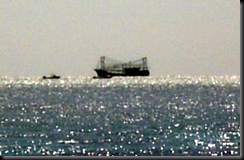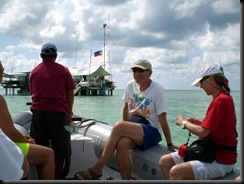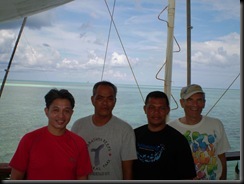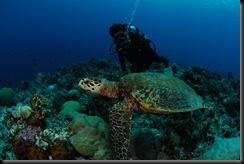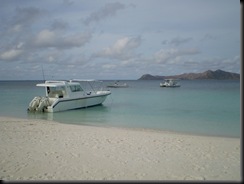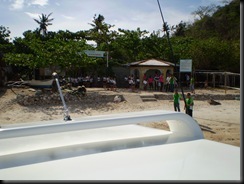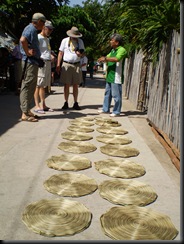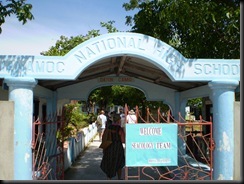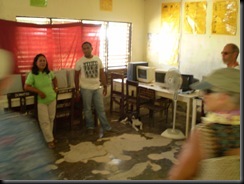Reliable, available 24/7, quiet, and best of all, clean. For some 80 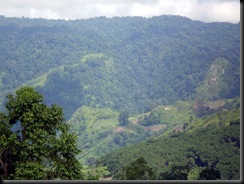 households in Sitio Lubo, May 9, 2013 marks the first time lights were turned on without having to check the juice in the solar batteries or the fuel in a gas- or diesel-fed generator. After waiting for nearly three years since the idea was first proposed, abundant water cascading from Lubo’s 2,500 hectares of watershed forest cranked the turbine that brought the first sparks of hydroelectricity to the isolated upland community.
households in Sitio Lubo, May 9, 2013 marks the first time lights were turned on without having to check the juice in the solar batteries or the fuel in a gas- or diesel-fed generator. After waiting for nearly three years since the idea was first proposed, abundant water cascading from Lubo’s 2,500 hectares of watershed forest cranked the turbine that brought the first sparks of hydroelectricity to the isolated upland community.
Construction of the micro-hydropower generator and its distribution network were both completely finished on March 22, 2013, three months to the day ago. A few problems with 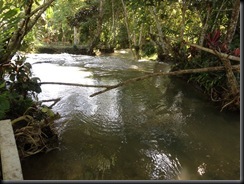 the generator’s “exciter” delayed its commissioning, but technical experts from AMORE, another of Seacology’s project partners, finally resolved the issues a couple of months later. The system was at long last turned over to the community on May 29, and the Lubo Renewable Energy and Community Development Association or LURECDA was promptly formed to manage its operations.
the generator’s “exciter” delayed its commissioning, but technical experts from AMORE, another of Seacology’s project partners, finally resolved the issues a couple of months later. The system was at long last turned over to the community on May 29, and the Lubo Renewable Energy and Community Development Association or LURECDA was promptly formed to manage its operations.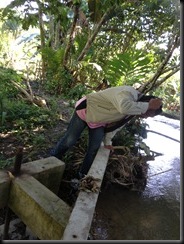
Scarcely had Yamog Executive Director Nonoy Cayayan and I got past the arduous 8-hour journey up the mountain last Saturday, June 22, when we overheard TV sets and radios from lit homes at Sitio Lubo’s outskirts. At their hearths, steaming electric rice cookers had replaced rice pots blackened by wood fire, a sharp contrast to my first visit in September 2010, when the few signs of electricity were powered either by a leased solar panel home system or a 2 to 3 kilowatt gas- or diesel-fed generator.
 I rode behind Allan Romano, himself a LURECDA board member, on his motorcycle as we worked our way up the mountain. Electric posts at intervals of about 20 meters lined the dirt road leading to Allan’s house where we were met by LURECDA officers. Ali Danyang, nephew of T’boli leader Victor Danyang whom we met at the tribe’s main house two years ago, represents the T’boli and Manobo tribes in LURECDA and was one of those who were on hand to greet us.
I rode behind Allan Romano, himself a LURECDA board member, on his motorcycle as we worked our way up the mountain. Electric posts at intervals of about 20 meters lined the dirt road leading to Allan’s house where we were met by LURECDA officers. Ali Danyang, nephew of T’boli leader Victor Danyang whom we met at the tribe’s main house two years ago, represents the T’boli and Manobo tribes in LURECDA and was one of those who were on hand to greet us.
Over 80 out of 250 households have initially signed up as beneficiaries of the 35 kilowatt micro-hydropower project, I was 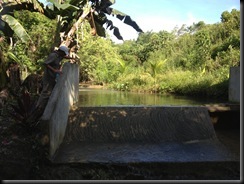 told, while those who have adopted a wait-and-see posture are showing considerable interest in getting connected as well. Meters had been installed in each of the electrified household. Electricity is free for the first month, then the monthly rate of P150 (about US$3.60) is charged for the first five kilowatt hours and P20 (US$0.48) for every kilowatt hour thereafter.
told, while those who have adopted a wait-and-see posture are showing considerable interest in getting connected as well. Meters had been installed in each of the electrified household. Electricity is free for the first month, then the monthly rate of P150 (about US$3.60) is charged for the first five kilowatt hours and P20 (US$0.48) for every kilowatt hour thereafter.
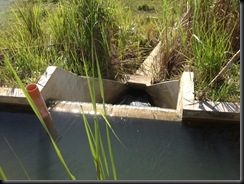 Each participating household shouldered the roughly P3,000 (US$71.40) for the meter, connection and household wiring. The LURECDA board members are reading the meters themselves according to their area assignments, and 11 community members successfully finished the training in the operation and maintenance of the micro-hydropower generator. Another board member doubles as the accountant. All in all, it would seem that the management side of the enterprise is off to a good start.
Each participating household shouldered the roughly P3,000 (US$71.40) for the meter, connection and household wiring. The LURECDA board members are reading the meters themselves according to their area assignments, and 11 community members successfully finished the training in the operation and maintenance of the micro-hydropower generator. Another board member doubles as the accountant. All in all, it would seem that the management side of the enterprise is off to a good start.
The T’boli and Manobo tribes who reside at the edges of the 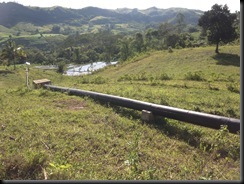 watershed in the upper reaches of Sitio Lubo are tasked to patrol the forests against poachers and to continue gathering wildlings for the nurseries. For their efforts, 10% of the micro-hydro’s monthly net income will be given to them. A covenant to this effect, drawn in the local dialect, was read and presented to Ali Danyang, to take to his uncle and tribe leader to study.
watershed in the upper reaches of Sitio Lubo are tasked to patrol the forests against poachers and to continue gathering wildlings for the nurseries. For their efforts, 10% of the micro-hydro’s monthly net income will be given to them. A covenant to this effect, drawn in the local dialect, was read and presented to Ali Danyang, to take to his uncle and tribe leader to study.
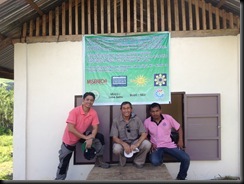 Another covenant was previously drawn up and signed, I was again told, since the signing of the first covenant between Seacology and Sitio Lubo’s leaders. This is between the Municipality of Lake Sebu, Barangay Ned, and Sitio Lubo, which essentially recognizes the importance of the watershed with respect to the micro-hydro, and assures that no activity deleterious to the forests therein will be allowed.
Another covenant was previously drawn up and signed, I was again told, since the signing of the first covenant between Seacology and Sitio Lubo’s leaders. This is between the Municipality of Lake Sebu, Barangay Ned, and Sitio Lubo, which essentially recognizes the importance of the watershed with respect to the micro-hydro, and assures that no activity deleterious to the forests therein will be allowed.
Perhaps they sense a certain solemnity and emotion or the reciprocation of 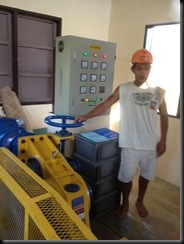 honor and respect in the word “covenant.” And they would not be very far off, because the first covenant with Seacology carried those, at least on Seacology’s part, when they agreed to protect 2,500 hectares of watershed forest within the 7,345 hectare ancestral claim of the T’boli and Manobo tribes in exchange for the micro-hydropower generator and fruit tree nursery. In the micro-hydro’s September 16, 2010 groundbreaking ceremonies, the first two covenants were buried in a time capsule capped by a circular cement marker. For anyone going to and from the powerhouse, it is a constant reminder of obligations that need keeping.
honor and respect in the word “covenant.” And they would not be very far off, because the first covenant with Seacology carried those, at least on Seacology’s part, when they agreed to protect 2,500 hectares of watershed forest within the 7,345 hectare ancestral claim of the T’boli and Manobo tribes in exchange for the micro-hydropower generator and fruit tree nursery. In the micro-hydro’s September 16, 2010 groundbreaking ceremonies, the first two covenants were buried in a time capsule capped by a circular cement marker. For anyone going to and from the powerhouse, it is a constant reminder of obligations that need keeping.
Among other points brought up is the complaint lodged by a mining company against the alleged unauthorized placement of an electric post inside its recently bought property. This would be the subject of a long huddle later on with the LURECDA board.
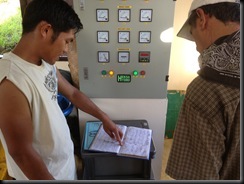 After resting a bit, we hiked down to the powerhouse, some 30 minutes away, where we saw first hand the micro-hydro at work. There we were met by Nga Villanueva, one of the recently trained operators and whose family donated the lot on which the powerhouse was built. A logbook records the town’s electrical consumption at certain times of day. Nga’s job is to regulate the flow of water through the turbine so that the electricity generated is just slightly above the total expected consumption. Ballasts mounted on the walls take up any excess electricity. At that moment, 5:00 pm, the total output was a little less than 5 kilowatts per hour, well below the micro-hydro’s 35 kilowatt per hour
After resting a bit, we hiked down to the powerhouse, some 30 minutes away, where we saw first hand the micro-hydro at work. There we were met by Nga Villanueva, one of the recently trained operators and whose family donated the lot on which the powerhouse was built. A logbook records the town’s electrical consumption at certain times of day. Nga’s job is to regulate the flow of water through the turbine so that the electricity generated is just slightly above the total expected consumption. Ballasts mounted on the walls take up any excess electricity. At that moment, 5:00 pm, the total output was a little less than 5 kilowatts per hour, well below the micro-hydro’s 35 kilowatt per hour 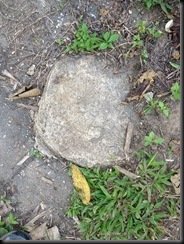 rating. From his growing experience, Nga is expecting consumption to rise a bit, maybe 3 or 4 kilowatts more per hour, as soon as it gets dark and more lights and appliances are turned on. There is definitely a lot of room for more consumers.
rating. From his growing experience, Nga is expecting consumption to rise a bit, maybe 3 or 4 kilowatts more per hour, as soon as it gets dark and more lights and appliances are turned on. There is definitely a lot of room for more consumers.
Nonoy noted that Lubo’s water has a very high calcium carbonate content, and that periodic cleaning of the pipes, headrace canal and turbine, perhaps as often as every 6 months, will be needed to remove the expected encrusting of sediments over time. That aside, adjusting the aperture of the gates and valves depending on the season (wet or dry) and the community’s consumption habits remains the only task the operators have to constantly keep watch for.
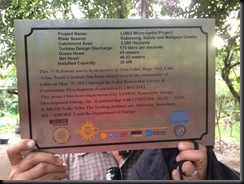 Nga went back to his nearby farm, where sacks of peanuts were waiting to be sealed, as we began our return to town before it got too dark. He and his workers have to bring the peanuts inside the shed while daylight still allows it. Sitio Lubo’s many farms produce corn and peanuts in the main, and Nga’s yields several sacks of high grade peanuts per planting cycle.
Nga went back to his nearby farm, where sacks of peanuts were waiting to be sealed, as we began our return to town before it got too dark. He and his workers have to bring the peanuts inside the shed while daylight still allows it. Sitio Lubo’s many farms produce corn and peanuts in the main, and Nga’s yields several sacks of high grade peanuts per planting cycle.
The micro-hydro is fed by only a tiny fraction of the water from Kabusong and Kalulong streams. It is the start of the dry season in the mountains, and the amount of water from the streams is expected to diminish by just a bit more until the next rainy season comes around. The available water however is so plentiful that the potential for expansion is undeniable. Should LURECDA manage its operations and finances well, they may be in a position to supply electricity to neighboring villages in the near future, particularly if 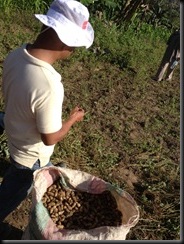 they are able to save enough to finance the construction of another micro-hydro.
they are able to save enough to finance the construction of another micro-hydro.
Minor management details were knocked around over dinner that night. At what point will they hire a full-time manager, accountant, meter reader and electrician? Would it be practical to ask the T’boli and Manobo to open their own bank account to facilitate the monthly transfer of funds? And so on. Good problems to have, being positive indicators of a business starting to take off. And then there was this 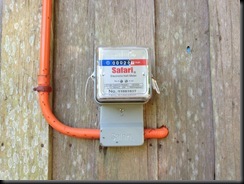 letter from the mining company.
letter from the mining company.
One of the burning issues in 2010, when I first came here, was the coal exploration being conducted by big companies in the area in spite of the community’s strong opposition. On balance is the potential damage to the watershed due to open pit mining, which is the usual method of extraction used. It seems that late that year, San Miguel Corporation, one of the nation’s biggest conglomerates, bought the coal mining franchises of several smaller mining companies (Daguma Agro Minerals Inc. and Sultan Energy Philippines Corp., among others) with the intention of diversifying into mining. These mining franchises are not in Sitio Lubo but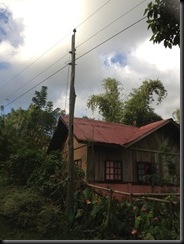 elsewhere in the Municipality of Lake Sebu. If reports are to be believed, the Daguma mountain range on which Sitio Lubo is located contains 426 million metric tons of “coal resources.” Big business, harkening to the imagined ka-ching of their cash registers, push on one side of the issue, and indigenous peoples, particularly the T’boli and Manobo tribes of Sitio Lubo, fearing the destruction of the watershed area in their ancestral domain, stand firmly opposed.
elsewhere in the Municipality of Lake Sebu. If reports are to be believed, the Daguma mountain range on which Sitio Lubo is located contains 426 million metric tons of “coal resources.” Big business, harkening to the imagined ka-ching of their cash registers, push on one side of the issue, and indigenous peoples, particularly the T’boli and Manobo tribes of Sitio Lubo, fearing the destruction of the watershed area in their ancestral domain, stand firmly opposed.
In 2011, San Miguel was able to purchase land on which one crucial transmission pole passes through by permission of the previous owner. After the micro-hydropower was commissioned, a series of letters were served on the community demanding that the pole and 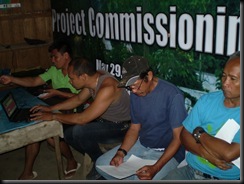 transmission line be taken off their property. The last one, dated June 15, gave LURECDA seven days to comply.
transmission line be taken off their property. The last one, dated June 15, gave LURECDA seven days to comply.
Being at the infancy of its operations, LURECDA is hard put to come up with the estimated P18,000 needed to uproot, replant the pole and modify the transmission lines accordingly, and no one as of yet is stepping forward to lend the amount – huge compared to Sitio Lubo’s average per capita income – despite what is looking like a threat of an expensive and drawn-out lawsuit. A board member posited that the unneighborly behavior is a warning, that San Miguel is showing that it can be a major inconvenience for their operations unless a certain arrangement 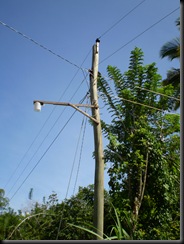 (mining rights?) can be agreed on.
(mining rights?) can be agreed on.
It was decided that they will meet with San Miguel’s representative and say that they will comply with San Miguel’s demand. But with an eye at San Miguel as a likely LURECDA client in the future, they will negotiate for an advance, P18,000 worth, to be deducted against the company’s electrical consumption when it eventually begins its business operations. Should bargaining fail, LURECDA or the community members themselves will just have to pool their money to remove, replant and rewire the pole. In any case, it was agreed that this problem can be licked one way or another if the board members remain united in their approach.
After breakfast at Allan’s house the next morning, we began our way down the mountain as the five Christian churches in town welcomed everyone for Sunday services.
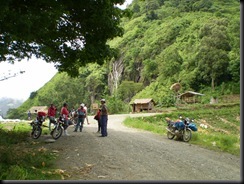 In the short time we were here, we witnessed Sitio Lubo townfolk who have managed to be very productive despite the odds in a distant mountain, and who have come up with common sense solutions to startup challenges. Industry, business acumen, and a lot of faith. It would certainly seem that the success of the micro-hydro is assured, and with it the continued preservation of Sitio Lubo’s watershed forest.
In the short time we were here, we witnessed Sitio Lubo townfolk who have managed to be very productive despite the odds in a distant mountain, and who have come up with common sense solutions to startup challenges. Industry, business acumen, and a lot of faith. It would certainly seem that the success of the micro-hydro is assured, and with it the continued preservation of Sitio Lubo’s watershed forest.

